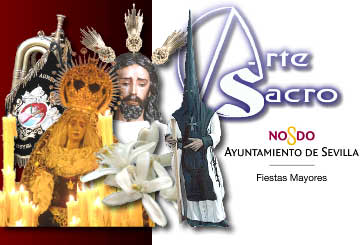
-oOo- The Handicraft -oOo-
 |
-oOo- The Handicraft -oOo- |
|
Sevillian imagery is right now a source of inspiration for the whole Spain and South America, recreating its images with the characteristic gothic style that made famous to the grater images maker of the XVI and XVII centuries (Martínez Montañés, Juan de Mesa, La Roldana) or later (XX century) on Castillo Lastrucci. This sculptural tradition has continued effective with names such as Salvador Illanes, Luis Alvarez Duarte, Antonio J. Dubé of Luque, Juan Manuel Miñaro, Manuel Hernández León, José Antonio Navarro or Manuel Ramos Corona. Too, we can find real art's works in the different compositions around the floats, and its be part of the respirators, silver and gold works and so on. They are little figureheads to explain cherubs, prophets, Moments in Christ's Passion or the Apostles. Maybe they aren't know because we be accustomed to see on top of the floats, but any sides of the floats have a unsurpassable great majesty.
And if we spoke of the hand of God to give form to the wood, the following step is the Gilding of the same one, as if it was a miracle, the wood becomes gold that, in spite of being metal, it goes extinguishing with the divine cry in rain form. Among the gilders we can find Manuel Calvo Carmona or Herrera and Feria. And those embroideries that give relief to Sacred María manto, are another great grateful handmade work and of great merit, the same as the palio and faldones. But the creation is not only present in the works of this corporation, the restoration is also an important work, reducing costs in view of the high price that can suppose to a Fraternity Embroidering a new manto. The Caro family, family Olmo, Santa Bárbara Workshop, José Ramón Paleteiro, Fernández and Enríquez or Grande de León workshops are good sample of artists dedicated to this work in group. And to put the finishing touch to the divine handicraft I will speak of the silver and other noble metals works in relief. The Gold and silvers works is in canopy's float , what are the gilders and carvers in that of Christ. Because silver itself has value, but in a gold works expert hands turn into art. Crowns, respiraderos, pedestals, varales, chandeliers, streetlights and line chandeliers, give to the canopy's floats that form so special and artistic of incalculable value.
And, in the Fraternities Processions, we find sticks, candles, banners, flags, etc, heading the sections of nazarenos and the Cruz de Guía, also of a great artistic value. Among the goldsmiths experts we can highlight to Fernando Marmolejo Camargo, Manuel Ríos Navarro (Andalusian Gold work), Cayetano González (Villarreal Gold work) and to Juan Borreo and Francisco Fernández (Triana Gold work). Photos: Francisco Santiago@ Vocabulary: Manto: A hug piece of rich materials which are delicately embroidered and flows from the Virgin over a hard support covering the back of the canopy's float Palio: A canopy supported by varales carrying the floats with the Virgin. Respiraderos: lateral parts to the floats Varales: Twelve vertical poles of the canopy's float. Potencias: Symbols on Christ's head that represent Memory, Understanding and Will in supreme degree. Cruz de Guía: A Cross banner which opens the processions. Andalucia: Region in the South of Spain (Europe), whose capital is Seville. Nazarenos: Members of the fraternities which make up the procession. Faldones: Piece of velvet which covers the men who carry the floats (costaleros).
|
|
|
Copyright 2004 Arte Sacro© www.artesacro.org - All rights reserved. |
|
|
Made in Seville - Spain |